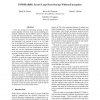490 search results - page 98 / 98 » A New Public-Key Cryptosystem |
PKC
1999
Springer
13 years 9 months ago
1999
Springer
One of the key directions in complexity theory which has also filtered through to cryptographic research, is the effort to classify related but seemingly distinct notions. Separa...
USENIX
2007
13 years 7 months ago
2007
Users are storing ever-increasing amounts of information digitally, driven by many factors including government regulations and the public’s desire to digitally record their per...
IEICET
2006
13 years 5 months ago
2006
We propose a new security class, called plaintext-simulatability, defined over the public-key encryption schemes. The notion of plaintext simulatability (denoted PS) is similar to ...
CRYPTO
2011
Springer
12 years 5 months ago
2011
Springer
Strong lattice reduction is the key element for most attacks against lattice-based cryptosystems. Between the strongest but impractical HKZ reduction and the weak but fast LLL redu...
IACR
2011
12 years 5 months ago
2011
Strong lattice reduction is the key element for most attacks against lattice-based cryptosystems. Between the strongest but impractical HKZ reduction and the weak but fast LLL redu...


